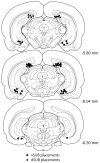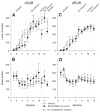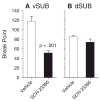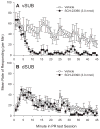Dissociating ventral and dorsal subicular dopamine D1 receptor involvement in instrumental learning, spontaneous motor behavior, and motivation
- PMID: 16768606
- PMCID: PMC2367311
- DOI: 10.1037/0735-7044.120.3.542
Dissociating ventral and dorsal subicular dopamine D1 receptor involvement in instrumental learning, spontaneous motor behavior, and motivation
Abstract
A series of experiments investigating the role of dopamine D1 receptors in the ventral subiculum (vSUB) and dorsal subiculum (dSUB), 2 subregions of the hippocampal formation, found that D1 receptor antagonism (3.0 nmol/0.5 microl SCH-23390 bilaterally) in the vSUB impaired instrumental learning and performance, reduced break point in progressive ratio (PR) tests, and produced an intrasession decline in responding during test sessions, but had no effect on spontaneous motor or food-directed behavior. In contrast, D1 receptor blockade in the dSUB had no effect on instrumental learning, performance, PR break point, or food-directed behavior, but reduced spontaneous motor behavior. These results suggest a dissociation between the vSUB and dSUB with respect to the role of dopamine in various aspects of motivated and motor behavior. Further, D1 activation in the vSUB may be a critical component of motivational arousal associated with learned contextual cues.
Copyright 2006 APA, all rights reserved.
Figures







Comment in
-
Integrating the subiculum into hippocampal formation circuitry and the control of instrumental behavior: theoretical comment on Andrzejewski, Spencer, and Kelley (2006).Behav Neurosci. 2006 Jun;120(3):739-43. doi: 10.1037/0735-7044.120.3.739. Behav Neurosci. 2006. PMID: 16768627
References
-
- Abel T, Lattal KM. Molecular mechanisms of memory acquisition, consolidation and retrieval. Current Opinion in Neurobiology. 2001;11:180–187. - PubMed
-
- Anderson MI, O’Mara SM. Responses of dorsal subicular neurons of rats during object exploration in an extended environment. Experimental Brain Research. 2004;159:519–529. - PubMed
-
- Baldwin AE, Holahan MR, Sadeghian K, Kelley AE. N-methyl-D-aspartate receptor-dependent plasticity within a distributed corticostriatal network mediates appetitive instrumental learning. Behavioral Neuroscience. 2000;114:84–98. - PubMed
-
- Bannerman DM, Deacon RM, Offen S, Friswell J, Grubb M, Rawlins JN. Double dissociation of function within the hippocampus: Spatial memory and hyponeophagia. Behavioral Neuroscience. 2002;116:884–901. - PubMed
Publication types
MeSH terms
Substances
Grants and funding
LinkOut - more resources
Full Text Sources
Research Materials
Miscellaneous

